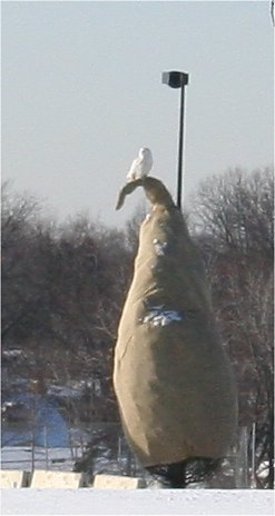 Seeing a Peregrine Falcon is not very unusual in southeast Michigan. Although they were not historically found in these parts, they were introduced into the city of Detroit beginning in 1987 as part of the Midwest Peregrine Restoration Program (MPRS). For the last 10 years, there have been five to seven Peregrine territories in southeast Michigan, including some now-traditional nest sites on rather famous
Seeing a Peregrine Falcon is not very unusual in southeast Michigan. Although they were not historically found in these parts, they were introduced into the city of Detroit beginning in 1987 as part of the Midwest Peregrine Restoration Program (MPRS). For the last 10 years, there have been five to seven Peregrine territories in southeast Michigan, including some now-traditional nest sites on rather famous
buildings in downtown Detroit, including the Whittier Apartments, the FisherBuilding, and the Book Building. So, we have resident birds in addition to migrants (the Southeast Michigan Raptor Research hawkwatch tallies about 50 each fall). I’ve even have one on my yard list.
Therefore it wasn’t too surprising that a pair (the male was banded with a MPRS band) took up housekeeping this spring on the central campus of the University of Michigan in Ann Arbor, on the Burton Memorial bell tower. Although a nest couldn’t be seen, the behavior of the birds indicated the female was on eggs for a time, but no young were produced (although the music was halted so as to not disturb them).
 The most interesting part of this story, to me, was that my friends over in the bird division at the Museum of Zoology routinely collected body parts at the base of the tower that had been dropped or not eaten by the falcons. They kept a running tally of prey items from the beginning of April through the end of October, with a two-week gap when the collection manager took a vacation.
The most interesting part of this story, to me, was that my friends over in the bird division at the Museum of Zoology routinely collected body parts at the base of the tower that had been dropped or not eaten by the falcons. They kept a running tally of prey items from the beginning of April through the end of October, with a two-week gap when the collection manager took a vacation.
Urban falcons are frequently said to favor Rock Pigeons as food. This pair had much more unorthodox tastes. I was quite astonished to see that the remains of at least 71 cuckoos were found at the tower, with slightly more Yellow-billed than Black-billed. Granted, Ann Arbor has quite a bit of green space, and there is a large cemetery, the arboretum, and parks along the Huron River in the vicinity, but I would not have imagined there being that many cuckoos around, especially careless ones.
These Peregrines must have specialized in secretive prey, as the leftovers also included nearly 20 rails, mostly Soras but including, incredibly, a Yellow Rail, a state-threatened species considered one of North America’s most elusive and mysterious birds, a species last recorded in Washtenaw County in 1925! Least Bittern was also on the menu, along with regular servings of Pied-billed Grebe, Green Heron, and Northern Flicker.
Not eaten regularly, despite their ubiquity, abundance, and reported favor, were Rock Pigeons, of which it appeared only about a half-dozen were taken. House Sparrows and European Starlings were represented on only two occasions each.
I found few readily available lists of Peregrine prey items. One from Regina, Saskatchewan was also heavy on grebes and Soras, but Rock Pigeons also came in at 18% of the prey. Prey analysis of Peregrines nesting at the University of Alberta in Edmonton show few Rock Pigeons but lots of gulls, and the web site notes the importance of marsh birds even in urban Peregrine diets. In the U.K., an observer of Peregrines in Bristol has come to the conclusion that the idea of pigeons as a staple food for city falcons is something of an urban myth.
This may be just as well. Analysis of a dead Peregrine from Baltimore in the 1980s [1] determined it had died of a gram-negative infection, associated with sublethal lead ingestion in other raptors. Pigeons made up 93% of this bird’s diet, and samples indicated very elevated levels of lead in the blood and organs of the pigeons — a common occurrence, at least at the time, for pigeons that lived in cities with high traffic density.
This might not be as great a threat now that leaded gasoline has been phased out. But studies in British Columbia have shown that although DDT has not been used since the 1970s in a local agricultural area, even short-lived birds are still contaminated with the break-down products. It was estimated [2] that feeding on as little as 10% of species such as starlings, robins, and gulls would have damaging effects on Peregrine eggs. Detroit Peregrines eat Ring-billed and Herring Gulls, which nest in the Detroit River. Levels of PCBs, DDE, and dioxins have remained steady or increased in local Herring Gull eggs the last decade. Contaminated prey in urban areas is just one more thing to consider when evaluating the wisdom of introducing wildlife into cities.
Hopefully, those cuckoos were clean-living, and the Ann Arbor Peregrines didn’t get a dose of unwanted chemicals with their exotic meals.
[1] DeMent, S.H., J.J. Chisholm, Jr., J.C. Barber, and J.D. Strandberg. 1986. Lead exposure in an urban Peregrine Falcon and its avian prey. Jrl. Wildlife Diseases 22:238-244.
[2] Elliott, J.E., Miller, M.J., and Wilson, L.K. 2005. Assessing breeding potential of peregrine falcons based on chlorinated hydrocarbon concentrations in prey. Environ Pollut. 134:353-61.
Photos from Wikipedia, falcon by Joe Kosack / PGC Photo.
 It has only been a week since winter rudely and abruptly arrived in Michigan. And what more appropriate bird to ease our transition to Arctic-like weather than a Snowy Owl? This bird was found by a friend who was driving through a big shopping center, in front of an incomplete big-box store, only a few miles from my house.
It has only been a week since winter rudely and abruptly arrived in Michigan. And what more appropriate bird to ease our transition to Arctic-like weather than a Snowy Owl? This bird was found by a friend who was driving through a big shopping center, in front of an incomplete big-box store, only a few miles from my house.







